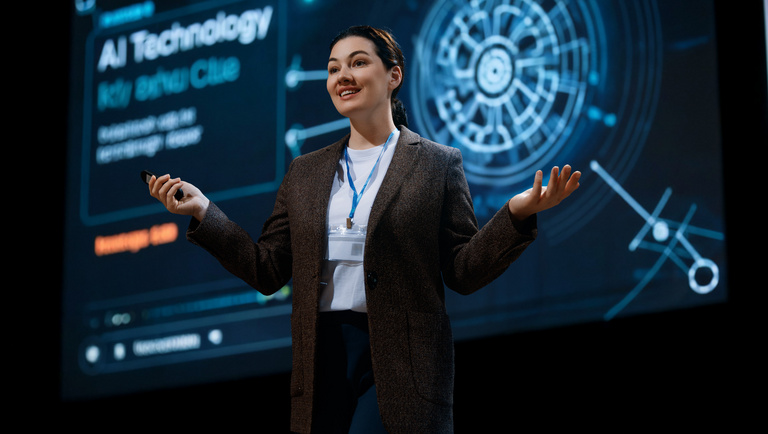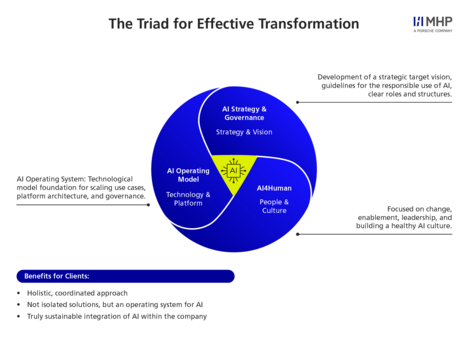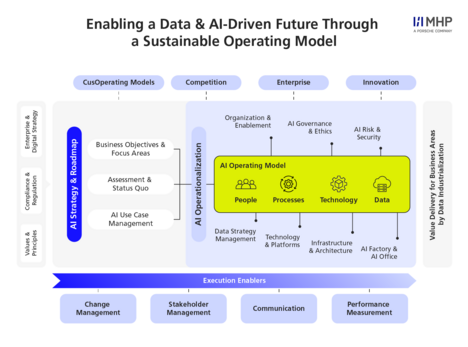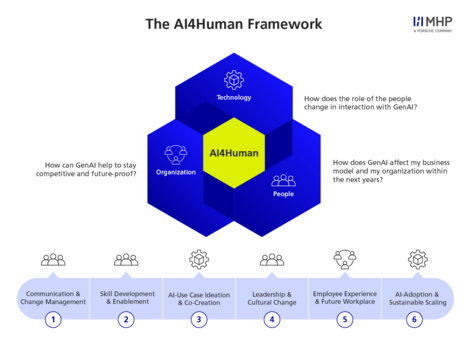
- Blog, Artificial Intelligence
- Published on: 09.07.2025
- 15:27 mins
AI Strategy and Culture: AI Transformation Starts with People
Artificial intelligence is considered one of the biggest game changers of our time. It is reshaping business models, value chains, and decision-making processes. Yet, despite significant investments, many initiatives remain stuck in the pilot phase. The reason is a lack of comprehensive AI strategies that unite technology, people, and corporate culture to ensure lasting, measurable business success through the right decisions and clear strategic priorities.
In many organizations, AI usage remains isolated. While individual teams or departments may use smart tools, this rarely creates real, scalable value for the business as a whole. Information must be processed multiple times, unused interfaces remain, and time gains are lost due to inconsistent processes. The core issue is that, despite widespread reports of increased efficiency, AI is still mostly seen as an assistant for specific tasks. Its true potential remains untapped.
AI generates greater value when embedded in various roles, such as a process companion, source of knowledge, or autonomous actor in dedicated workflows. This creates a holistic learning system that can meet internal and external demands. A non-technical, collaborative approach enables organizations to leverage the innovative power and collective intelligence of their entire team.
What is missing is a true transformation that goes far beyond implementing new technologies and begins with people. After all, it is people who turn data into insights and applications into real progress. An effective AI strategy provides guidance and ensures artificial intelligence becomes an integral part of daily work across all functions. A strong AI culture empowers people to leverage its potential out of conviction, not obligation. This is especially important now, as emerging technologies like agentic AI offer new automation opportunities in which employees and autonomous agents redefine entire areas of work together.
In this article, we will show you how to successfully drive AI transformation in your organization by aligning your strategy, structure, and culture.
Challenges in AI Transformation
Artificial intelligence promises efficiency, innovation, and new business models. However, the path to realizing these benefits is complex and rarely purely technological. Many companies underestimate the fact that a sustainable AI transformation is also always a cultural shift. Several key challenges must be addressed to successfully and scalably embed AI within an organization:
Lack of a unified strategic vision
Without a clear, strategically anchored vision, there is no common thread. All too often, AI initiatives are developed in isolation from the broader corporate strategy. In fact, an effective AI strategy should be systematically derived from the overall business and digital strategy. Consistent direction can only be established when the strategic goals a company wants to achieve with AI are clearly defined and aligned with the overarching vision. A well-designed target operating model then defines how the organization, its processes, technology, and data interact, laying the foundation for the effective implementation of AI across departments.
No strategic or cultural framework
Transformation requires more than just the introduction of new technology, it requires cultural alignment. Change can only be accepted and actively shaped if it occurs within a clear, understandable framework. This also means providing early guidance, involving leadership, and fostering transparency.
Fragmented AI initiatives
Many companies start with isolated use cases and lack an overarching concept. The result is parallel solutions, missed synergies, and duplicated efforts. An effective AI strategy connects business processes, technology, and people, ensuring that initiatives contribute to shared goals.
A true AI-first approach is built on the following principles:
- Data logic before process logic
- Platform toolbox instead of black box
- Infrastructure (system) before application
The key is not individual applications, service solutions, or products, but rather the infrastructure, systems, and interfaces that connect them. It is also essential to consider the future potential for efficiency, cost savings, and new business models enabled by AI.
Insufficient employee enablement
Technology only becomes effective when employees are ready and able to use it meaningfully. This requires structured training programs, clear communication, and concrete use cases. Only then can the necessary understanding, trust, and engagement develop.
What Do AI Strategy and Culture Mean and Why Are They Important?
Implementing artificial intelligence is not just an IT project; it is a profound transformation process. Organizations that want to successfully integrate AI need more than tools, use cases, and data platforms. They also need clear strategic direction and a culture that embraces openness and a willingness to learn and adapt.
From vision to impact with a clear AI strategy
This strategic direction begins with a clear vision and is systematically derived from the overarching business and digital strategies. An effective AI strategy then defines what the company aims to achieve with AI, how it plans to get there, and why. The AI strategy serves as an orientation framework, a priority-setting tool, and a means of empowerment. It connects technological potential with business objectives, ensuring that AI becomes a unifying element across the organization rather than an isolated solution.
AI culture: the foundation for sustainable transformation
Technology alone cannot transform an organization. People do. A strong AI culture creates conditions that allow employees to understand, support, and shape change. True transformation occurs when artificial intelligence becomes embedded in a company's values, routines, and ways of thinking. AI culture is reflected not in code, but in the behavior of those working with it.
The key lies in combining both perspectives. Strategy and culture are two sides of the same coin. The best architecture means nothing without the people who use it, and cultural openness alone is not enough without clear guidelines. Only then can AI evolve from a project to a reality and from a tool to a true value driver.
The Three Pillars of Effective AI Transformation Are: Strategy, Structure, and Culture
Artificial intelligence can only generate lasting value when strategic goals, technological infrastructure, and cultural integration are systematically aligned. These three dimensions are only truly effective when they are designed and implemented as an integrated whole.
1. AI strategy: the north star for your organization
A solid AI strategy answers key questions such as:
- Why is your company investing in AI? What is the target vision?
- What are the relevant areas of application and use cases?
- How will you implement it successfully, both technically and ethically, while complying with regulations?
A well-grounded assessment of your current position is the starting point. A maturity assessment reveals how advanced your organization is in working with data and AI. A gap analysis identifies missing skills, processes, or technologies. Based on these results, we develop a roadmap that is both ambitious and realistic. The scope and depth of the assessment are tailored to your specific context and business areas.
One thing is clear: A defined strategy document should be a living framework adaptable to the company’s evolving needs. It should incorporate regulatory requirements, such as the EU AI Act, as well as ethical principles. Additionally, the strategy links business goals with application clusters, which are strategic groups of use cases within each business unit.
Fundamentally, an AI strategy must foster a shift in mindset. AI is not just a feature or project, it is a principle that, in many cases, demands a completely new approach. Companies that embrace this don't think in terms of isolated use cases as is common in traditional data management. Instead, they think in terms of global platforms, structures, and enablement. The future belongs to companies that make knowledge accessible, enable collaboration between humans and machines, and empower employees to build their own AI tools.
2. Target operating model: the organizational, procedural, and technological backbone
A solid AI strategy is ineffective if it cannot be translated into day-to-day operations. The AI Operating Model provides the structural foundation for successful AI transformation, ensuring that technology, processes, data, and the organization work together seamlessly.
MHP AI Operating Model in Brief
The MHP AI Operating Model is more than a technological architecture; it is a scalable operating system for productive AI use across the entire organization. Key benefits at a glance:
Efficiency and innovation: Deploy specialized AI assistants exactly where they streamline processes, accelerate workflows, and measurably increase productivity.
Full data sovereignty: Your information stays within your infrastructure, complying with regulations such as the Data & AI Act.
Seamless integration: Hyperscaler- and LLM-agnostic (GPT-4o, Claude, Gemini, etc.). Deeply integrates with existing systems instead of using isolated APIs.
Scalable and secure: Robust cloud architecture, LLM operations, and the Use-Case Factory enable rapid scaling from pilot to enterprise rollout.
Brand-compliant: A flexible design system adapts to your corporate identity, providing powerful AI without compromising brand consistency.
Learn more about the AI Operating Model and how it can empower your organization to use AI productively, securely, and scalably.
The holistic operating model is based on four central fields of action:
1. People & Enablement
It defines roles, responsibilities, and required skills. It ensures that employees are engaged, trained, and empowered. This includes, among other things:
- Change management frameworks
- Targeted training and enablement programs
- Building data & AI communities
- Establishing an AI-first mentality in everyday work
2. Process
Operationalize strategic goals through clear standards, guidelines, and workflows:
- Establishment and management of AI-specific processes
- Stakeholder management and accountability models
- Governance structures, ethical guidelines, and risk management
- Support through tools and automation
3. Technology & Platform
Provides the technological infrastructure and platform landscape through which AI initiatives can be implemented, orchestrated, and developed further:
- System landscape analysis and tool integration
- Authentication strategies and technological scaling
- Demand management and resource planning
4. Data Foundation
It lays the foundation for data quality and transparency:
- Building a robust data & AI catalog
- Ensuring data flows through IT systems
- Data quality management and data ethics
- Development of a comprehensive enterprise data model
The AI operating model is a flexible framework that can be tailored to your organization's maturity level and goals. It offers both orientation and flexibility, ensuring that your AI strategy can be implemented in an integrated and scalable way, not failing due to departmental boundaries or technology gaps.
Our solution at MHP, IntelliCore, provides all the prerequisites to implement this framework. It:
- Defines aligned roles, processes, data flows, and technology components
- Bundles enablement, governance, and performance management under one roof
- Is modular and iterative, from the first use case to enterprise-wide scaling.
This allows for a more holistic approach than other organizational models, such as the centralized hub-and-spoke, specialized center of excellence, or team-based data mesh.
AI4Human: the human lever
Technology only unfolds its full impact when people are ready and able to use it meaningfully. In many companies, AI transformation fails not because of technology but because of a lack of acceptance, uncertainty, or missing know-how. This is precisely why targeted cultural embedding is essential. Enablement, communication, and leadership become strategic success factors.
It is about more than just technology training. True AI excellence emerges through deliberate preparation and structured collaboration, not spontaneous inspiration. Working with AI requires discipline and clear processes comparable to those of a real project team. Standards, systematic tool integration, and continuous feedback ensure that isolated AI assistants evolve into a coordinated network of human and artificial actors.
A people-centric AI approach includes:
- Communication and change management: Changes must be clearly explained, expectations must be transparent, and concerns must be addressed. It is essential to provide clarity about why and where the transformation is heading in order to build trust and encourage participation. AI transformation is also always a cultural change, a profound shift in mindsets, work routines, and interpersonal collaboration, that must be strategically planned and carefully implemented.
- Competence development and enablement: Training, learning journeys, and awareness programs foster an understanding of AI and encourage its active use in daily work. It's not just about tools; it's also about attitude, judgment, and responsibility
- Use-case ideation and co-creation: Employees should be involved as co-creators of meaningful use cases, not mere "users". This fosters genuine relevance and connection to the technology.
- Leadership and cultural change: Leaders play a central role. They provide guidance, demonstrate the change, and actively support teams as they try out new ways of working. In this context, leadership means empowering rather than controlling.
- Employee experience and future of work: AI is becoming part of everyday work. Therefore, it is all the more important to further develop work models and digital skills that focus on collaboration, autonomy, and meaningful activities.
- Scaling and sustainable embedding: Individual initiatives are not enough. AI is only holistically integrated into the organization through systematic scaling, for example via an AI Factory and a supporting AI Office.
Those who want to use AI creatively must challenge it and actively contribute ideas. Creative excellence emerges when diverse human and artificial perspectives converge. The more task areas that AI takes on independently or as a sparring partner, the more space remains for true co-creation.
In dynamic teams where humans and AI take on different roles, routine tasks are not only accelerated, but innovation processes are also deliberately supported. The quality of the output depends on how flexibly the team roles are designed and how systematically feedback is provided to the AI.
However, without people, every AI initiative remains fragmented. Only through a human-centered approach does AI become more than a tool, a true value driver, and does the transformation evolve from a project into a lived reality.
MHP Is Your Partner for a Successful AI Transformation
Developing and implementing an AI strategy can be complex, but it doesn't have to be complicated. With a structured approach, a proven model, and a clear focus on people, transformation becomes achievable. This is where MHP comes in. We support you throughout your entire transformation journey, from inspiration to a fully embedded AI culture.
Our approach combines strategic development, structural setup, and cultural integration. With our reliable AI Operating Model, scalable IntelliCore platform solution, and clear framework for enablement and leadership, we lay the foundation for long-term impact. We identify relevant use cases and operationalize them across the entire value chain to ensure that AI is fully embedded, not just introduced.
Throughout this process, we prioritize people, integrate governance from the beginning, and ensure a smooth fit with existing structures. This approach enables a successful start and sustainable scaling.
The journey progresses from isolated applications to AI assistants and, ultimately, to fully integrated, collaborative AI teams. The most effective teams combine human and artificial intelligence flexibly, based on roles, and through dialogue. The future belongs to those who delegate tasks to AI and grow alongside their digital teammates. AI teamwork is no longer a distant vision. It is already the key to innovation and lasting success.
Conclusion: AI Creates Impact When People Help Shape It
Artificial intelligence can unlock enormous potential, but only if its implementation is strategically planned, structurally supported, and culturally embedded. A successful AI transformation is not just an IT project. It is a holistic shift that affects the entire organization. It marks a transformative turning point in business strategy. AI applications like Agentic AI enhance operational excellence and beyond. They also become strategic assets in connected ecosystems, ranging from manufacturing companies to service platforms.
In the future, business success will depend on the ability to collaborate across networks, including partners and suppliers. This is why an AI strategy must include an ecosystem perspective. Agents can work across traditional barriers, such as silos, teams, and departments, overcoming limits that were once considered inherent to established companies. Organizations and their decision-makers must learn to think in terms of cross-functional workflows and processes. They must allow AI to observe and decide while establishing goals, boundaries, and governance.
The focus should be on the people using the tools, not the tools themselves. These individuals require guidance, training, and trust to seamlessly integrate AI into their daily work. The temptation to settle for the first workable solution is high, especially when multiple AI roles are involved. However, true creativity begins after that. Real innovation happens when options are compared, ideas are refined, and new perspectives are continuously explored. Smart orchestration of collaboration between AI and human teams helps break routines and steadily improve results.
Only when strategy, structure, and culture work together can lasting value be created for the organization and every individual.
FAQ
A well-thought-out AI strategy provides direction, aligns initiatives, and ensures that artificial intelligence creates real value. These benefits can include more efficient processes, data-driven decisions, higher customer satisfaction, and greater innovation. It also enables organizations to leverage AI as a strategic advantage within connected ecosystems and establish cross-functional workflows where agents transcend silos and make autonomous decisions.
An effective AI strategy begins with a clear vision and is systematically derived from the overarching business and digital strategies. Consider what you want AI to achieve within your company and how that aligns with your broader business goals. Based on this, an initial assessment covering technical, organizational, and cultural aspects is carried out, followed by the identification of relevant use cases and the development of a roadmap. The roadmap should align with your organization's maturity level, business objectives, and employees. A key principle is to think in terms of platforms from the start rather than isolated solutions and to always include the ecosystem perspective.
Before getting started, you need a clear understanding of your current position. A tailored assessment of your current state across all essential dimensions is the foundation of any successful AI initiative. It systematically analyzes your existing capabilities, processes, technologies, and data landscape. This provides a clear picture of your potential and concrete areas for improvement. Based on this assessment, you can define realistic goals and develop a strategic roadmap that includes targeted lighthouse projects to quickly generate value and build trust in the transformation.
An AI-first strategy integrates artificial intelligence into business strategy, processes, and decision-making instead of using it sporadically. Key principles include data logic over process logic, modular platform architecture instead of black-box solutions, and infrastructure before application. Crucially, AI-first always means human-first as well. Without acceptance, enablement, and cultural integration, AI remains merely a tool with no real impact.





